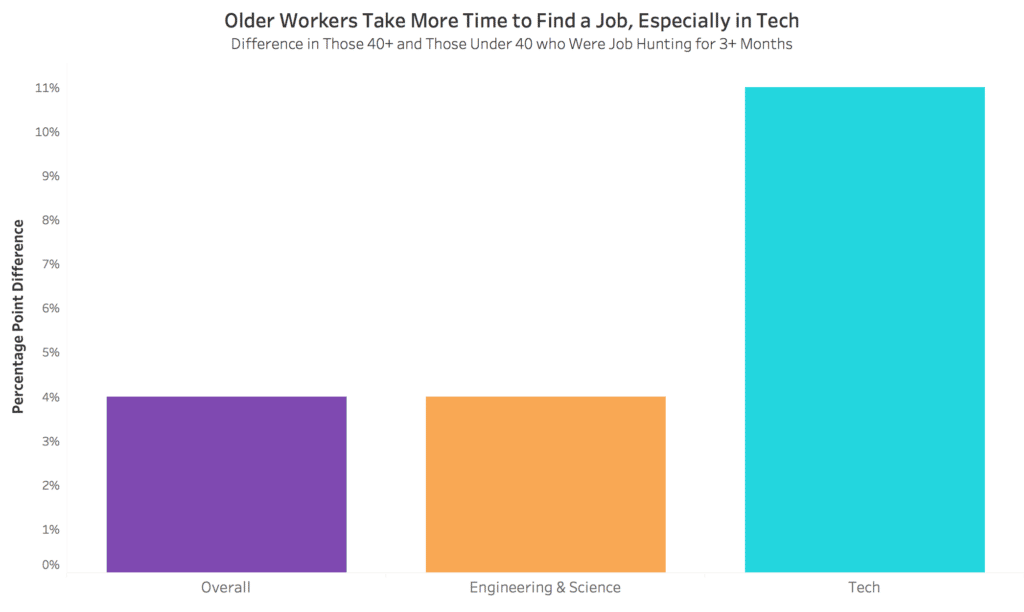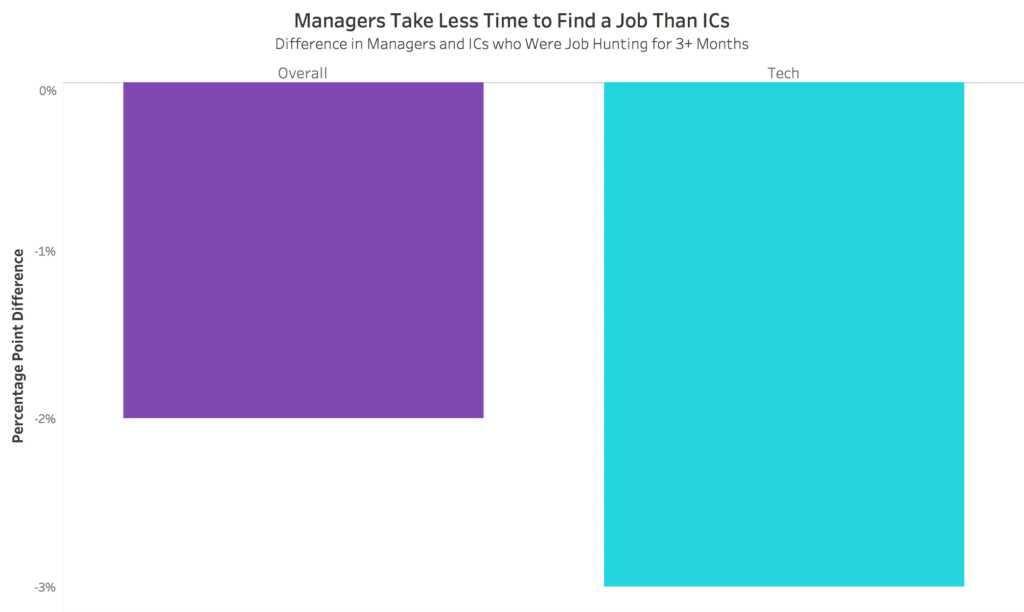The Financial Time’s declaration that “Apple has built an office for grownups” was not just a review of Apple’s new headquarters. It was a criticism of tech’s hoodie and ping pong culture that caters to the young. While tech firms may be swapping out bean bag chairs for high-design furniture, our research suggests that tech is still not a friendly place for older workers.
Silicon Valley Is 47 Years Old. But Can a 47-Year-Old Find a Job There?
Between November 2017 and May 2018, PayScale surveyed nearly 10,000 respondents who were unemployed at the time and were evaluating new job offers. We asked how long they had been actively seeking a job along with the industry in which they had a job offer. To see how age may impact search time, we divided the sample into workers who are protected from age discrimination by the Age Discrimination in Employment Act (i.e. those 40 and older), and those who are not.
Overall, we found that older workers tend to spend more time looking for jobs. Across all industries, those 40+ are four percentage points more likely than their younger colleagues to be job hunting for three months or more. However, the divide between old and young is much larger in tech. Older workers are 11 percentage points more likely to still be looking for a job after three months.
This significant difference is not because young techies can find jobs at light-speed. This gap exists because the percentage of older workers who have been searching for more than three months is much higher in tech (41 percent) than the economy as a whole (34 percent).
The large difference that we see in tech is not something that holds across all technical fields. The engineering and science industry is largely in-line with the economy as a whole—older workers are four percentage points more likely than younger workers to spend more than three months looking for a new job.
But Is It Ageism?
One possible explanation for a higher percentage of older workers still job hunting after three months is that those 40+ may be looking for scarcer but more senior positions. However, we find the contrary when we look at how long it takes those who are at least a manger to find a job as compared to individual contributors. Overall, managers are two percentage points less likely than individual contributors to be job hunting after three months. In tech, managers do even better: they are three percentage points less likely than individual contributors to be looking for a job for longer than three months. Job level, therefore, is unlikely to be the underlying reason it takes older techies longer to find a job.

Another potential explanation: perhaps older techies don’t have what employers are looking for. However, a recent HackerRank study showed that the number one attribute that companies look for when they hire developers is experience. The study also showed that older developers embrace newer, in-demand languages like Scala while younger devs tend to dislike them. In the abstract, older workers appear to have everything employers are looking for.

To sum it all up: it takes longer for older tech workers to find jobs. It isn’t because they are looking for higher-level positions. It isn’t because companies don’t value experience. And it isn’t because they don’t have the skills employers are looking for. While tech companies may be building offices for grown-ups, it looks like they may still prefer to hire hoodie-wearing wunderkinds.
Ageism Leads to Bad Outcomes
Age bias leads to bad outcomes for workers and companies. For older techies, longer search times can have a large impact on income. Our research on career disruptions showed that the wage penalty for unemployment is significant, and the longer the career disruption, the greater the penalty.
For businesses, companies who want experience are shooting themselves in the foot by overlooking those who are most likely to have it—older workers. If you’re a hiring manager or an HR pro, there is a lot you can do to avoid age bias in the hiring process and help your company hire the best person for the job. Even if they don’t wear hoodies.
Methodology
Between November 2017 and May 2018, PayScale asked respondents to our job offer survey the following questions.
- Are you currently employed?
- Yes, at this same company
- Yes, but at a different country
- No
- [If no] How long have you been actively seeking a job?
- Less than 3 months
- 3-6 months
- 6-12 months
- 12-18 months
- 18-24 months
- More than 24 months
Nearly 10,000 respondents who were unemployed at the time and were evaluating new job offers answered the later question.
We group workers into two job levels.
- Individual Contributors – Employees who do not manage others.
- Managers – This includes:
- Managers/Supervisors: Employees with people management responsibilities.
- Directors: Employees who manage managers but are below the level of vice president.
- Executives: Employees with the title of vice president or higher.


